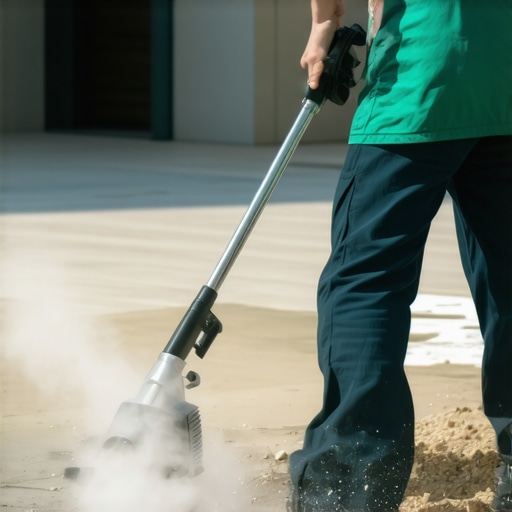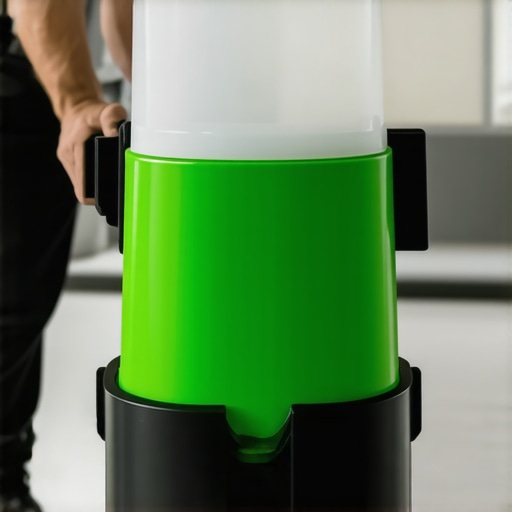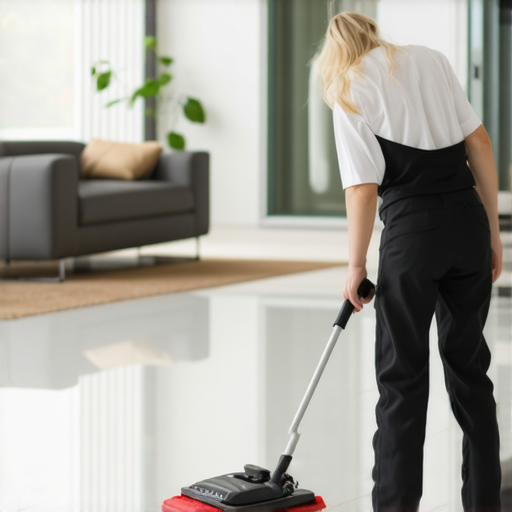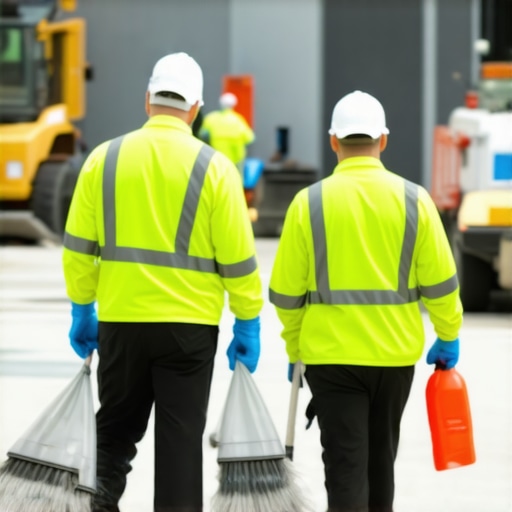My First Post-Construction Cleaning Experience: A Challenge Turned Opportunity
When I first stepped into a newly renovated home, I was overwhelmed by the dust, debris, and stubborn stains that seemed to cling to every surface. As someone passionate about creating a healthy living environment, I realized that effective post-construction cleaning is crucial for both safety and sustainability. This personal encounter sparked my journey into discovering the best strategies for quick, eco-friendly sanitation that truly makes a difference.
Understanding the Importance of Post-Construction Cleaning
Post-construction cleaning isn’t just about aesthetics; it’s about ensuring the space is safe and free from harmful particles. I learned that without proper cleaning, dust and residual chemicals can impact indoor air quality, affecting health and comfort. Incorporating green cleaning practices not only benefits the environment but also promotes a healthier home, aligning with insights from green cleaning tips.
My Go-To Tips for Fast and Eco-Friendly Sanitation
How Do I Tackle Dust and Debris Efficiently?
My secret is to start with a thorough vacuuming using HEPA filters, which trap tiny particles that regular vacuums might miss. I also prefer using microfiber cloths for wiping surfaces, as they require less chemical cleaner and are highly effective. This approach speeds up the process and minimizes environmental impact.
What Are My Favorite Eco-Friendly Cleaning Products?
I swear by natural solutions like vinegar and baking soda for most cleaning tasks. These ingredients are safe, affordable, and powerful against grime. For tougher stains, I turn to eco-conscious commercial products that are certified for sustainability, like those recommended by eco-friendly hacks.
Can Sustainability Be Fast and Effective?
Absolutely! I’ve found that combining quick cleaning techniques with sustainable products yields impressive results. For example, using biodegradable wipes and eco-friendly disinfectants not only cleans thoroughly but also reduces chemical runoff, supporting a greener planet. For more insights on sustainable cleaning methods, I refer to sustainable cleaning methods.
Why Is Proper Post-Construction Sanitation Critical?
Proper sanitation prevents health issues caused by residual dust and chemicals. It also enhances the longevity of newly installed surfaces and fixtures. I’ve seen firsthand how a meticulous cleaning session transforms a chaotic space into a pristine, safe haven.
What Are the Best Tools and Techniques for Rapid Results?
Using specialized tools like steam cleaners and eco-friendly scrub brushes accelerates cleaning without compromising quality. I also schedule cleaning in stages, focusing on high-traffic areas first, which provides quick visible improvements. For instant, eco-friendly solutions, I check out sustainable solutions that shine.
If you’re embarking on a post-construction cleanup, I highly recommend sharing your experiences or tips below. It’s inspiring to learn from others who prioritize cleanliness and sustainability!
For more expert advice, don’t hesitate to explore our contact page.
Innovating Post-Construction Sanitation: Advanced Techniques for Eco-Conscious Professionals
Building on foundational practices, seasoned cleaners are now turning to innovative methods that blend speed with sustainability. One such approach involves the use of **steam cleaning technology**, which effectively sanitizes surfaces without the need for harsh chemicals. This method not only accelerates the cleaning process but also minimizes chemical runoff, aligning with eco-friendly standards. For those interested in integrating this technology, exploring options like eco-friendly steam cleaners can be beneficial, and resources such as post-construction solutions that shine offer valuable insights.
What Are the Nuances of Choosing the Right Eco-Friendly Cleaning Equipment?
When selecting tools, it’s crucial to consider their energy efficiency, durability, and environmental impact. High-quality steam cleaners with certified low emissions provide a safer alternative to chemical disinfectants. Additionally, scrub brushes made from biodegradable materials ensure that every aspect of your cleaning arsenal supports sustainability. The key is to balance performance with eco-consciousness, ensuring that your methods are both effective and responsible. For tailored advice, consulting trusted sources like eco-friendly hacks can guide your choices.
Integrating Green Protocols into Rapid Sanitation Routines
Modern post-construction cleaning emphasizes **multi-stage protocols** that maximize efficiency. Beginning with high-vacuuming using HEPA filters, followed by targeted surface treatments with biodegradable disinfectants, ensures comprehensive sanitation within tight timelines. Using **layered cleaning techniques**—such as initial dust removal, followed by deep cleaning of high-touch surfaces—can drastically reduce turnaround times without sacrificing quality. For instant results, I recommend exploring ultimate eco-friendly secrets.
Can Sustainable Cleaning Methods Match the Speed of Traditional Approaches?
Absolutely. Advances in eco-friendly cleaning products and tools have closed the gap significantly. For example, fast-acting biodegradable wipes and disinfectants now deliver comparable results to conventional chemical solutions in a fraction of the time. Moreover, employing **dual-purpose cleaning solutions** helps streamline workflows, saving both time and resources. It’s important to evaluate your specific project needs and select products that offer rapid efficacy while adhering to green standards. To deepen your understanding, reviewing post-construction sanitization secrets can provide practical guidance.
If you’re refining your cleaning protocols or discovering new eco-friendly tools, sharing your experiences can foster a community of sustainable practitioners. Feel free to comment or suggest further reading that has helped you succeed in eco-conscious post-construction sanitation!
For additional expert insights, visit our contact page.
Embracing the Nuances of Eco-Conscious Cleaning: A Personal Reflection
As I delved deeper into sustainable post-construction cleaning, I realized that every project presents unique challenges that demand tailored solutions. For instance, tackling stubborn residues from modern adhesives or sealants often requires a nuanced approach that balances efficacy with eco-friendliness. Over time, I learned to experiment with biodegradable, enzyme-based cleaners that break down complex residues without harming the environment, a practice I now highly recommend to fellow practitioners seeking responsible yet effective results. Incorporating these advanced techniques has transformed my workflow, making it more adaptable and aligned with my core values of sustainability.
What Are the Hidden Complexities in Choosing Truly Green Equipment?
Choosing the right tools isn’t merely about brand names or initial costs; it involves understanding the lifecycle of equipment and its overall environmental footprint. I discovered that some energy-efficient devices might use components that are difficult to recycle or dispose of responsibly. This insight prompted me to scrutinize certifications such as ENERGY STAR or EPEAT, which assess the full environmental impact of products. For example, selecting a steam cleaner with low emissions and energy consumption not only accelerates sanitization but also minimizes ecological harm, aligning with insights from eco-friendly hacks. It’s these layered considerations that elevate a routine cleaning into a truly sustainable practice.
How Do I Balance Speed with Deep Sustainability in Tight Deadlines?
One of the most complex dilemmas I faced was maintaining rapid turnaround times without compromising eco principles. I found that integrating multi-stage, layered cleaning protocols—starting with high-efficiency dust removal, followed by eco-friendly disinfecting—can be both swift and thorough. For instance, using biodegradable wipes for high-touch areas allows for quick sanitation, while steam cleaning handles the deep cleaning of surfaces that require more intensive treatment. This approach, combined with planning stages meticulously, helps me deliver quick results that are also environmentally responsible. For more detailed strategies, I often refer to post-construction sanitization secrets.

Sharing these nuanced insights with colleagues or clients not only fosters trust but also advances a collective commitment to greener practices. I encourage you to reflect on your own experiences—have you encountered similar complexities? What innovative solutions have you adopted? Your stories can inspire others to refine their methods and embrace more sustainable, effective cleaning practices.
For further exploration of advanced eco-friendly cleaning techniques, visit our contact page. Continuing to learn and adapt is vital in this evolving field, and your input is invaluable in shaping a future where cleanliness and sustainability go hand in hand.
Unveiling the Nuances of Eco-Friendly Residue Removal in Post-Construction Cleanup
One of the most intricate aspects of sustainable post-construction cleaning involves addressing stubborn residues from modern adhesives, sealants, and finishing compounds. These substances often contain complex chemical compositions that challenge even seasoned professionals. My approach has evolved to incorporate **enzymatic cleaners** derived from biodegradable sources, which effectively break down organic residues without releasing harmful toxins into the environment. Such solutions require careful application and a deep understanding of material interactions, ensuring both efficacy and eco-responsibility. This nuanced technique has significantly enhanced my ability to deliver meticulous results while adhering to green standards, aligning with insights from eco-conscious sanitization practices.
Deciphering the Lifecycle Impact of Eco-Friendly Equipment for Sustainable Sanitation
Choosing truly green equipment transcends initial certifications; it demands a comprehensive analysis of the entire lifecycle, from manufacturing to disposal. I discovered that some energy-efficient devices, despite their low operational emissions, may incorporate components that are difficult to recycle or contain hazardous materials in their production phases. To navigate this complexity, I rely on stringent certifications such as **EPEAT** and **ENERGY STAR**, which evaluate environmental impact at every stage. For example, selecting a steam cleaner with certified low emissions and recyclable parts ensures that my cleaning arsenal remains aligned with my sustainability commitments. This layered approach to equipment selection elevates routine cleaning into a responsible practice, as emphasized by authoritative sources like eco-friendly hacks.
Balancing Speed with Deep Sustainability: Advanced Strategies for Tight Deadlines
One of the most demanding challenges I face is maintaining rapid turnaround times without compromising on eco principles. My solution involves **multi-stage cleaning protocols** that optimize efficiency and ecological responsibility. Beginning with high-efficiency HEPA vacuuming to swiftly remove airborne dust, followed by targeted application of biodegradable disinfectants on high-touch surfaces, I achieve comprehensive sanitation within demanding schedules. Incorporating **layered cleaning techniques**—starting from dust removal to deep cleaning—allows for swift progress while maintaining high standards. For further insights on streamlining eco-friendly routines, I recommend exploring advanced sanitization secrets.

Engaging with colleagues or clients about these sophisticated methods fosters a shared commitment to sustainability and continuous improvement. I invite you to reflect—have you encountered similar complexities? What innovative solutions have you devised? Sharing your experiences can inspire a broader community dedicated to responsible cleaning practices.
For more in-depth strategies and expert guidance, visit our contact page.
Things I Wish I Knew Earlier (or You Might Find Surprising)
1. The Hidden Power of Microfiber Cloths
When I first started post-construction cleaning, I underestimated the effectiveness of microfiber cloths. These humble tools can trap tiny dust particles better than traditional rags, reducing the need for chemical cleaners. I remember the first time I used them; I was amazed at how much dust they picked up, speeding up my workflow significantly.
2. Eco-Friendly Products Can Be Just as Tough
Many people think green cleaning products are less effective, but I found quite the opposite. Natural solutions like vinegar and baking soda work wonders on stubborn stains and residues. Plus, they’re safe for the environment and my family. This realization was a game-changer in my approach to cleaning sustainably.
3. The Lifecycle of Equipment Matters
Choosing eco-friendly equipment isn’t just about certifications. I’ve learned to consider the entire lifecycle—how products are made, used, and disposed of. Opting for items with certifications like ENERGY STAR ensures I’m making responsible choices that support sustainability long-term.
4. Speed Doesn’t Have to Sacrifice Sustainability
Balancing quick results with green practices was a challenge at first. However, I discovered that layering techniques—like starting with high-efficiency vacuuming and finishing with biodegradable disinfectants—allowed me to work fast without compromising eco principles. This approach has helped me meet tight deadlines responsibly.
5. Residue Removal Requires Nuance
Modern adhesives and sealants leave residues that are tough to clean without harsh chemicals. I now use enzymatic cleaners that break down organic residues safely, which has greatly improved my results and aligned with my eco-conscious values. It’s a nuanced process but worth the effort.
6. The Importance of Certifications in Tools
Not all energy-efficient tools are created equal. I’ve become diligent in checking certifications like EPEAT, ensuring that my equipment supports my sustainability goals. This diligence helps me avoid tools with hidden environmental costs, making my cleaning practices truly responsible.
Resources I’ve Come to Trust Over Time
- EPA’s Green Cleaning Program: A comprehensive resource on environmentally friendly cleaning standards that I recommend to anyone serious about sustainability.
- Green Seal: Certifies cleaning products that meet strict environmental and health standards, helping me choose safer options.
- Energy Star: Guides me in selecting energy-efficient appliances that minimize ecological impact during operation.
- Enzymatic Cleaners: I’ve found these particularly effective for residue removal, and they’re a great eco-friendly alternative to harsh chemicals.
Parting Thoughts from My Perspective
Reflecting on my journey into eco-friendly post-construction cleaning, I realize that the most valuable lesson is the importance of balancing speed with sustainability. Every project presents unique challenges, but with the right tools, techniques, and mindset, it’s possible to deliver excellent results responsibly. If this resonates with you, I’d love to hear your thoughts or experiences. Feel free to share your insights or ask questions—together, we can make cleaning greener and more effective. Remember, responsible cleaning not only benefits the environment but also creates healthier spaces for everyone. For more guidance, don’t hesitate to visit our contact page.

